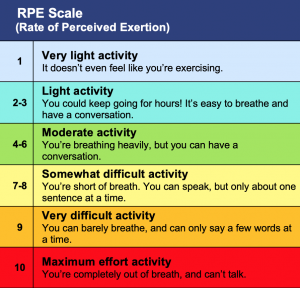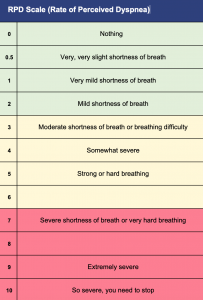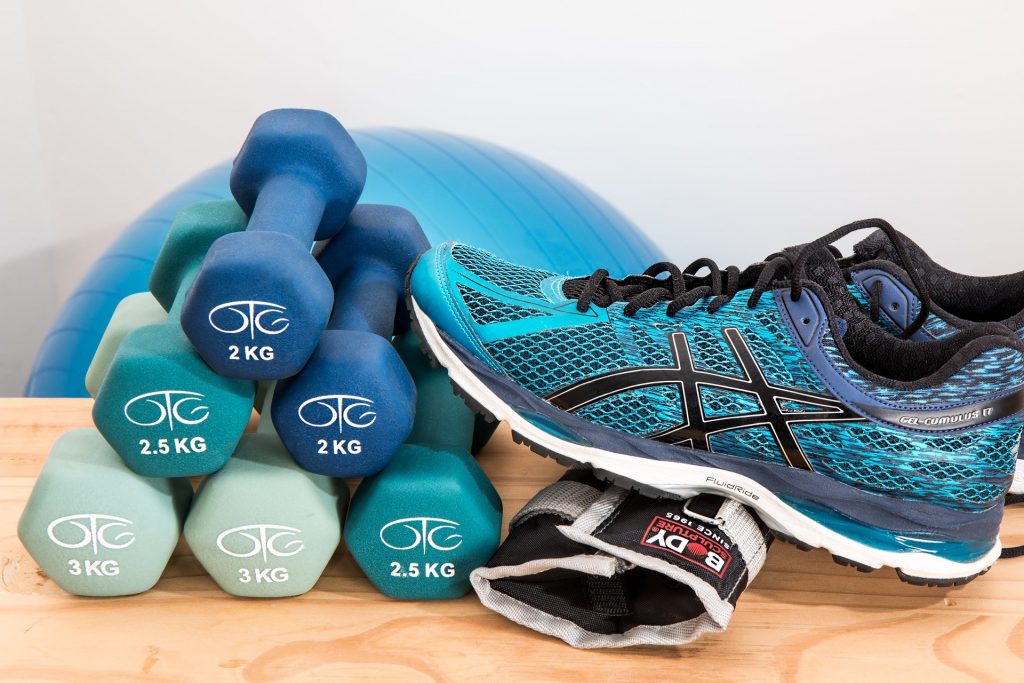Monitoring your exertion (effort) during exercise is critical for anyone beginning a program. But, it’s even more important when you have Alpha-1 lung disease. Monitoring lets you get the most benefit from your program, and ensures that you’re safe and comfortable.
Download Exertion and Exercise Safety – What You Need to Know as a PDF.
As your fitness improves, you’ll notice that activities that once were difficult now take less time and effort. When you’re ready to challenge yourself, monitoring tools help you do it safely.
Most people without lung disease use a Target Heart Rate to find the right intensity for their exercise program. But Alphas with moderate to severe lung disease don’t have the same level of respiratory function. They should find the right intensity by using
- The Borg Scale for Rating Perceived Exertion
- The Borg Scale for Rating Perceived Dyspnea (shortness of breath)
Monitor exertion with The BORG Scale for Rating Perceived Exertion (RPE)
This scale helps you monitor the intensity of your exercise and learn to manage daily activities. Benefits of using the RPE include:
- Increased exercise tolerance and improved respiratory function
- Less risk of injury
- No special skills or equipment required
- Lets you maintain your exercise pace
How to use RPE
The RPE measures your exertion or effort on a scale from 0 to 10. For example, sitting quietly in a chair may have a rating of 0. Waving your arms while sitting might increase the exertion rating to 0.5. And, you might give walking at a moderate pace a rating of three.
Don’t base your rating on pace or speed. Base it on how hard you feel like you’re working. Walking on a flat path might be a three. But, add some hills and your RPE could increase to a six, even if you’re walking slowly.
People with Alpha-1 lung disease should aim for an RPE between 3 (moderate) and 4 (somewhat strong).
Let RPE be your guide
Reduce the intensity of your exercise if
- You’re short of breath and coordinated breathing doesn’t help.
- You have aches and pains 20 to 30 minutes after your exercise session
Adjust your exercise until you think your RPE is about 1-2. Then, slowly increase your effort until it reaches 3-4.

Modified BORG Scale for Rating Perceived Dyspnea (RPD)
This scale helps you figure out how breathless you feel while exercising or doing daily tasks.
How to use RPD
The RPD measures your shortness of breath on a scale from 0 (none) to 10 (so much you have to stop your activity). Using RPD with RPE helps you monitor both aspects of your exercise program — and adjust if you need to.
As your strength and endurance improve with exercise, the feeling of breathlessness will decrease when you’re exercising at the same level. You may also notice that daily tasks don’t take all your energy or leave you feeling short of breath.

Designing your personal exercise program
Now that you know how to monitor your exercises, you must choose what type or mode of exercise to do. We recommend choosing activities that
- You like to do
- You have easy access to
- Are right for your fitness level
- Challenge you safely
The possibilities are endless!
A good exercise program consists of three parts:
Warm-up and stretching (flexibility training)
- Prepares you for physical exertion
- Improves your flexibility and coordination
- Prepares the muscles in your belly, pelvis to help you with the work of breathing
Muscle strengthening (strength training)
- Also called resistance or weight training
- Improves muscle endurance to improve your ability to work (and play) without getting tired
Cardiovascular exercise (cardio endurance training)
- Strenuous activity that increases circulation
- Improves heart and respiratory function
- Includes walking, cycling, rowing, swimming, and playing sports
Challenge yourself safely!
Adding some physical activity to your daily routine gives you many health benefits. When you’re ready to push yourself a little harder, remember:
Increase the duration (how long you exercise) before you increase intensity (higher on the RPE scale). If you have unusual symptoms or feel uncomfortable, decrease the intensity until the symptoms go away.
For more in-depth information on this topic, please visit the Big Fat Reference Guide (BFRG). If you are enrolled in AlphaNet’s Subscriber Portal, you can access the BFRG here.
Download Exertion and Exercise Safety – What You Need to Know as a PDF.

